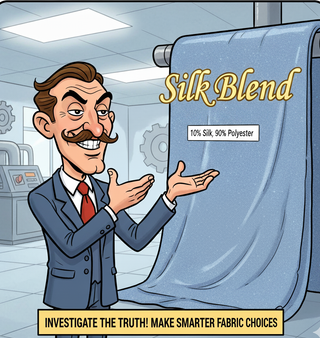Key Takeaways
-
To tell whether something is very high quality, look at its fiber composition, GSM, drape, and certifications.
-
Sustainable fashion textiles are soft, long-lasting, and good for the environment.
-
Don't only trust marketing words; look at the facts to prevent being tricked by fabric makers.
-
To get the most out of your clothes, buy wardrobe basics made from high-quality textiles.
When it comes to shopping for fashion fabrics online, it's all too easy to feel like you're in a labyrinth. The images are shiny, the descriptions sound right, but here's the truth: are you actually buying premium or just creative marketing? The fashion industry is driven by looks, and local fabric manufacturers have gotten very good at marketing their average fabrics as "high quality".
Did You Know?
A 2020 McKinsey survey revealed that 67% of consumers consider the use of sustainable materials an important purchasing factor in fashion.
At Litlook, we understand how zapped, overwhelmed, and confused you might feel when shopping for fabrics online. That is why we have created this guide to help you decode how to look for overpriced or premium fabrics so that you can invest confidently.
Why premium fabrics matter more than just the look

Premium materials do more than look good; they also change how clothes feel, how long they endure, and how confident you feel wearing them. Consider this: the fit of a blazer is important, but if the fabric pills after two wears, the whole appearance comes apart.
Here's why you should never take fabric choice lightly:
-
Long-lasting: High-end fabrics don't fade, shrink, or rip.
-
Comfort: Natural fabrics creathe better and adjust to the weather.
-
Looks: A high-quality cloth drapes beautifully, making it look more exquisite.
-
Eco-value: Many sustainable fashion fabrics reduce harmful chemical usage and water waste.
What do you think? The perfect fabric doesn't simply make garments look better; it makes you look better.
How to spot luxury without being misled by fabric manufacturers

Don't be fooled by shiny phrases like "premium," "exclusive," or "heritage quality." These words are often used without regard to the fabrics used and, for all intents and purposes, transport the same fibers and fabrics as any other fabric -they merely imply a luxury. To outsmart the marketing tricks used by fabric manufacturers, you should dive into the details.
Look for the following:
-
Fibre content: 100% silk, cotton, or linen will always be stronger than the polyester content of other blends.
-
Weave of the fabric: Look closely; Premium fabrics will always have a similar grain, tightness of weave.
-
Weight (GSM) - Higher GSM means a stronger, longer-lasting fabric.
-
Authentic Carrie hibastians - OEKO-TEX, or GOTS certification.
-
End user reviews - actual consumers tend to comment on actual feel, weight, or function.
When you focus on the details, you will quantify the true fabrics even when perusing an online catalog.
Can you really judge fashion fabrics online without touching them?
Yes, for sure. Touch is still the best way to tell whether something is good, but online consumers may still figure out if something is good by looking for specific signs. Imagine it as a "digital feel test."
Things to look for:
-
Descriptions of drapes: Words like "fluid," "structured," or "stiff" tell you how the cloth will flow.
-
Wrinkle recovery: Fabrics of high quality bounce back after being creased. It's worth noticing if a product says this.
-
Seller transparency: Trustworthy merchants are transparent about the GSM, fabric origin, and certifications.
If you put these signals together, you will frequently know more about the cloth than someone who is just shopping.
Why sustainable fashion fabrics define modern luxury
Things have changed in luxury. It's not about having too much anymore; it's about being responsible. People today want garments that feel good on their skin and are in line with their ideals. This is why sustainable fashion fabrics are the new gold standard.
Why they matter:
-
They are naturally softer and have fewer toxins left over from processing.
-
Fibers that are strong, like hemp and Tencel, endure longer than synthetic mixtures.
-
Less harm to the environment without losing beauty.
This is why organic cotton, bamboo, and Tencel are quickly becoming must-haves in high-end fashion. Not only are they soft, but they also have a purpose.
How fabric manufacturers disguise mediocrity as premium

This is the portion you need to pay particular attention to. Some fabric manufacturers call their textiles "luxury" by adding a small amount of high-quality fiber to an otherwise mediocre blend. A garment that says "silk blend" might be 90% polyester and merely 10% silk.
-
Renaming polyester with fancy commercial names is another technique.
-
Too much emphasis on colors and patterns instead of fiber quality.
-
Even for mass products, "imported" is used as a fake sign of luxury.
It will be simpler to ignore the noise and focus on what actually matters—the textile's actual build—once you know these tricks.
Make smarter fabric choices

The secret is out: the cloth is what makes fashion powerful. You can prevent frequent mistakes, improve your wardrobe, and gain lasting value from every purchase by knowing how to spot actual quality. Litlook can help you choose fashion fabrics that will change not only your style but also your confidence.
FAQs
Is it possible to determine the quality of cloth online without touching it?
Yes. To make an informed choice, look at the fiber content, weave characteristics, GSM, drape description, and how open the vendor is.
Are textiles made from sustainable materials as nice as typical high-end fabrics?
Definitely, Tencel, hemp, and organic cotton are all strong, comfortable, and good for the environment, and they all stay high quality.
How do makers of low-quality textiles make them seem like high-quality ones?
They typically mix a little amount of expensive fibers with cheaper synthetics, give regular textiles new names, or put too much emphasis on color and design instead of quality.
What trendy textiles are worth buying?
Tailored blazers, silk skirts, cashmere coats, and breathable linen suits are all classic examples of how high-quality textiles can add value over time.

